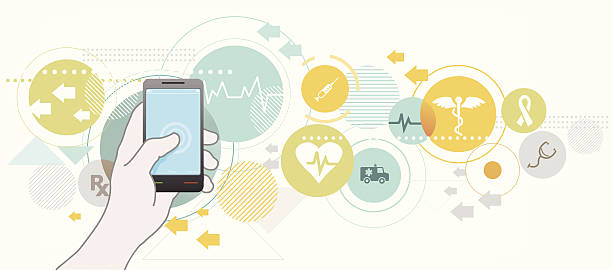Mobile health (mHealth) is the use of mobile devices and technologies for medical and public health practice. mHealth is a component of electronic health (eHealth) that supports medical and public health practice, through the use of mobile phones, patient monitoring devices, personal digital assistants (PDAs) and other wireless devices.
mHealth was born out of the growing need for mobile networks which offer high data transmission speed, and the ability to transform health services information assessment, delivery, and management. This need and the rapid spread of mobile phone users and technologies in phone applications have resulted in advancements in this field.
Over the past 15 years, the use of mobile phones for healthcare delivery has increased. Mobile health technologies and apps are being used to provide preventive health care services like check-ups, screenings, and teleconsultations. These services are utilized by health care professionals, as well as individuals and organizations, to promote proactiveness, and reduce the financial burden and resource pressures on health systems. It was also used to facilitate mass health information communication, provide telemedical care, and correct misinformation and misconceptions during the COVID-19 lockdown period.
Also, information communication and data capturing abilities of mobile health technologies have also reduced untimely reporting, prevented governments from suppressing information, and facilitated responses to outbreaks and emerging situations. All these present-day advantages can be due to the increase in the number of smartphone users from what it was in 2016 (less than half of the global population) to what it is today (Above 6 billion smartphone users).
However, despite its growing need and potential to transform the face of health service delivery across the globe, mHealth technology and service adoption still face certain barriers. Barriers like ignorance and illiteracy among users, lack of training among facilitators, the possibility of data loss from wireless internet support services, and unwillingness to adopt such services among the target populations can hinder futuristic applications. When addressed, these technologies can be used to support the achievement of global health objectives. Solutions to these barriers include education and training, addressing privacy and confidentiality concerns, mass communication, and mass campaigns or promotions to targeted users.
As a digital health organization, eHealth4everyone is invested in the present and future of mobile health technology use. We are currently fostering mobile health tech use with the development of mobile and web-based technologies such as Carekojo (an assistive mobile and web-based technology), and Datakojo (a user-friendly data collection and storage tool), the Multi-Source Data Analytics and Triangulation (MSDAT); Africa’s Public Health Network (APHeN) mobile, Virtual reality for essential neonatal care and phobia, Open health Insurance System and Analytics (OpenHISA), and Dhistance (the world’s first fully automated DHIS2 hosting and server management system).
Reach out to us for any concerns or questions you might have about them.
External links:
https://mhealth.jmir.org/2018/4/e109/
https://mhealth.jmir.org/2020/1/e12516/
https://www.journalofcomprehensivehealth.co.in/jch/article/view/75
https://www.ncbi.nlm.nih.gov/pmc/articles/PMC2917042/
https://www.nveo.org/index.php/journal/article/view/3462/2837
https://onlinelibrary.wiley.com/doi/abs/10.1111/isj.12179
https://www.statista.com/statistics/263437/global-smartphone-sales-to-end-users-since-2007/
https://www.bankmycell.com/blog/how-many-phones-are-in-the-world
https://synapse.koreamed.org/articles/1147966




